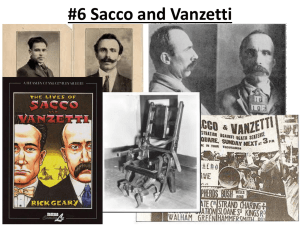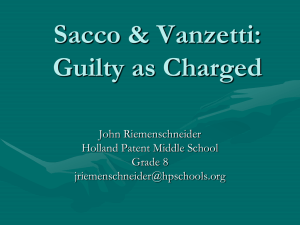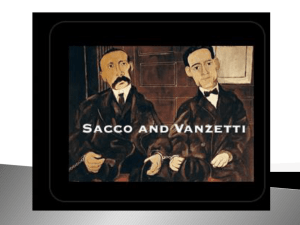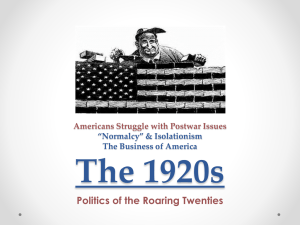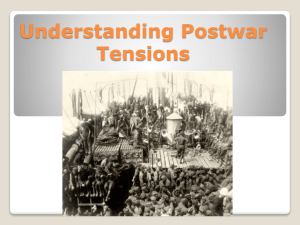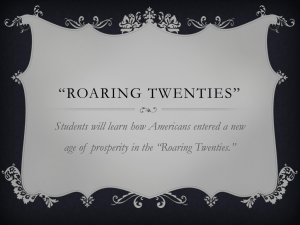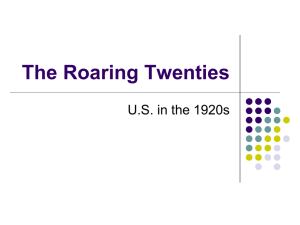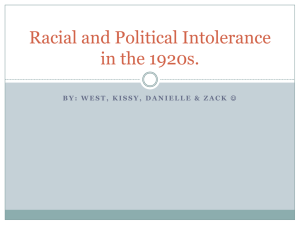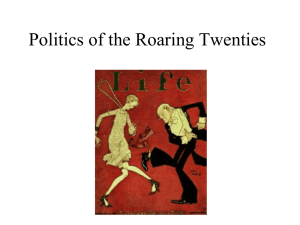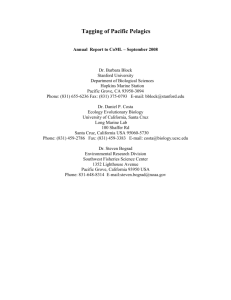Shane-SaccoVanzetti
advertisement
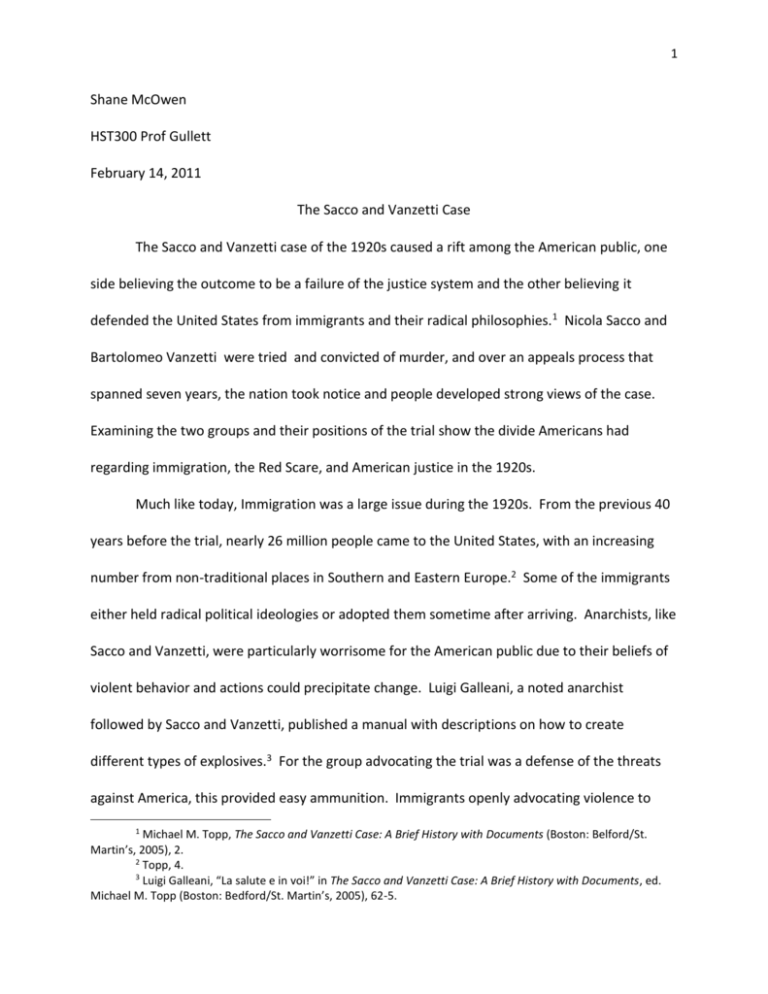
1 Shane McOwen HST300 Prof Gullett February 14, 2011 The Sacco and Vanzetti Case The Sacco and Vanzetti case of the 1920s caused a rift among the American public, one side believing the outcome to be a failure of the justice system and the other believing it defended the United States from immigrants and their radical philosophies.1 Nicola Sacco and Bartolomeo Vanzetti were tried and convicted of murder, and over an appeals process that spanned seven years, the nation took notice and people developed strong views of the case. Examining the two groups and their positions of the trial show the divide Americans had regarding immigration, the Red Scare, and American justice in the 1920s. Much like today, Immigration was a large issue during the 1920s. From the previous 40 years before the trial, nearly 26 million people came to the United States, with an increasing number from non-traditional places in Southern and Eastern Europe.2 Some of the immigrants either held radical political ideologies or adopted them sometime after arriving. Anarchists, like Sacco and Vanzetti, were particularly worrisome for the American public due to their beliefs of violent behavior and actions could precipitate change. Luigi Galleani, a noted anarchist followed by Sacco and Vanzetti, published a manual with descriptions on how to create different types of explosives.3 For the group advocating the trial was a defense of the threats against America, this provided easy ammunition. Immigrants openly advocating violence to 1 Michael M. Topp, The Sacco and Vanzetti Case: A Brief History with Documents (Boston: Belford/St. Martin’s, 2005), 2. 2 Topp, 4. 3 Luigi Galleani, “La salute e in voi!” in The Sacco and Vanzetti Case: A Brief History with Documents, ed. Michael M. Topp (Boston: Bedford/St. Martin’s, 2005), 62-5. 2 Americans certainly would cause a distain for the foreigners, and sympathy for Sacco and Vanzetti ‘s trial would be hard to come by with both men belonging to anarchist group and its violent tendencies. Even immigrants without anarchist or socialist political views had a difficult time in 1920s America. Gino Speranza wrote the difficulties of assimilation of foreigners to the American lifestyle was the faults of both parties and differences would continue to mount with the divide between the two groups.4 As Speranza shows, the influx of people from Italy and other places were not always welcomed with open arms, and immigrants like Galleani furthered the stigma placed upon them by Americans. The post World War I Red Scare was the result of the fear of social revolution in the American public. World War I was an unpopular cause for many, resulting in laws created to suppress criticism against the government and governmental decisions.5 The success of the Bloshevik Revolution in Russia and the widespread strikes that totaled around 4 million people in 1919 put Americans on edge and fearful of a revolution happening on their home front. 6 Louis Post, the assistant secretary of labor during the early years of the case, saw firsthand the effects of the Red Scare. He detailed arrests and searches made without warrants in the New England area, to which only less than 10 had a technical cause for deportation out of the initial 800 to 1,200 arrests.7 Sacco and Vanzetti, immigrants with their association in a violent, radical group caused enough distress to the public to receive much attention in America. Even though 4 Gino Speranza, “How it Feels to Be a Problem” in The Sacco and Vanzetti Case: A Brief History with Documents, ed. Michael M. Topp (Boston: Bedford/St. Martin’s, 2005), 53-5. 5 Topp, 16. 6 Topp, 15, 186. 7 Louis Post, “The Deportations Delirium of Nineteen-Twenty” in The Sacco and Vanzetti Case: A Brief History with Documents, ed. Michael M. Topp (Boston: Bedford/St. Martin’s, 2005), 82-4. 3 the height of the Red Scare ended near the beginning of their trial, there was enough fear to garnish support against them, even in a case with faulty facts and evidence. The court case itself is where the most division across America came from. One side found the proceedings unfair; that the trial lack crucial evidence placing Sacco and Vanzetti as the murderers. The other side felt this was part of a larger sentiment of protecting the United States against radical immigrants and their threats to society. Vanzetti realized that he and Sacco were facing punishment for their radical views, and that the presiding judge of the case, Jude Thayer, was trying to “twist” the facts to get them the death sentence instead of deporting them back to Italy.8 There was no hard evidence suggesting Sacco or Vanzetti had anything to with the murders they were being tried for.9 FBI agent Fred J. Weyand concluded that the crimes were likely done by professional criminals, and the only thing they were guilty of was violating the Selective Service rules for the draft during World War I.10 The group against Sacco and Vanzetti used jury’s verdict of proof of their guilt, but still rallied around the larger cause. Frank Goodwin described the case being well-known as a “blessing in disguise.” It let America’s enemies know they were not going to back down to threats, that the American way was going to stand up to the Reds and their allies.11 Judge 8 Bartolomeo Vanzetti, “Background of the Plymouth Trial” in The Sacco and Vanzetti Case: A Brief History with Documents, ed. Michael M. Topp (Boston: Bedford/St. Martin’s, 2005), 86-7. 9 Topp, 18. 10 Fred J. Wayand, “Affidavits” in The Sacco and Vanzetti Case: A Brief History with Documents, ed. Michael M. Topp (Boston: Bedford/St. Martin’s, 2005), 122. 11 Frank Goodwin, “Sacco-Vanzetti and the Red Peril: Speech before the Lawrence, Massachusetts, Kiwanis Club” in The Sacco and Vanzetti Case: A Brief History with Documents, ed. Michael M. Topp (Boston: Bedford/St. Martin’s, 2005), 151-2. 4 Thayer said the crime committed by the two men was consistent with Vanzetti’s beliefs as a radical.12 The major evidence of the case took a back seat to the division the case caused in America. It was many on the left who were outraged by the conviction and questioning the free speech in America 12 John Dos Passos, “Facing the Chair” in The Sacco and Vanzetti Case: A Brief History with Documents, ed. Michael M. Topp (Boston: Bedford/St. Martin’s, 2005), 149.
